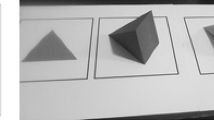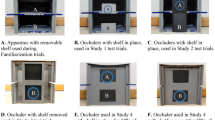Abstract
The study explores whether the naive concepts of solid and liquid persist in adolescence. Accuracy of responses and reaction times where measured while 41 ninth graders classified different solids (rigid, non-rigid and powders) and different liquids (runny, dense) into solid or liquid. The results show that these naive conceptions affect adolescences’ classifications in terms of both accuracy and reaction time. The rate of correct classifications of non-rigid solids and powders was significantly lower than of rigid solids. Lower rate of success was also found for classification of dense liquids compared with runny liquids. In addition, the reaction time results of correct classifications for non-rigid solids and powders were longer than those for rigid solids and, likewise, reaction times for dense liquids were longer than for runny ones. These results suggest that reasoning processes associated with correct classification of objects that are not consistent with the naive conceptions are more demanding.

Similar content being viewed by others
References
Babai R, Brecher T, Stavy R, Tirosh D (2006a) Intuitive interference in probabilistic reasoning. Int J Sci Math Educ 4:627–639. doi:10.1007/s10763-006-9031-1
Babai R, Levyadun T, Stavy R, Tirosh D (2006b) Intuitive rules in science and mathematics: a reaction time study. Int J Math Educ Sci Technol 37:913–924. doi:10.1080/00207390600794958
Denes G, Pizzamiglio L (1999) Handbook of clinical and experimental neuropsychology. Psychology Press, Hove, UK, pp 28–30
Evans JBT, Over DE (1996) Rationality and reasoning. Psychology Press, Hove
Fensham PJ (1994) Beginning to teach chemistry. In: Fensham PJ, Gunstone RF, White RT (eds) The content of science: a constructivist approach to its teaching and learning. Falmer Press, London, UK, pp 14–28
Justi RS, Gilbert JK (2002) Modelling, teachers’ views on the nature of modelling, and implications for the education of modellers. Int J Sci Educ 24:369–387. doi:10.1080/09500690110110142
Kandel ER, Schwartz JH, Jessell TM (2000) Principles of neural science, 4th edn. McGraw-Hill, New York, pp 661–662
Krnel D, Glazar SS, Watson R (2003) The development of the concept of “matter”: a cross-age study of how children classify materials. Sci Educ 87:621–639. doi:10.1002/sce.10080
Krnel D, Watson R, Glazar SA (2005) The development of the concept of ‘matter’: a cross-age study of how children describe materials. Int J Sci Educ 27:367–383. doi:10.1080/09500690412331314441
Liu X, Lesniak KM (2005) Students’ progression of understanding the matter concept from elementary to high school. Sci Educ 89:433–450. doi:10.1002/sce.20056
Norenzayan A, Smith EE, Kim B, Nisbett RE (2002) Cultural preferences for formal versus intuitive reasoning. Cogn Sci 26:653–684
Opfer JE, Siegler RS (2004) Revisiting preschoolers’ living things concept: a microgenetic analysis of conceptual change in basic biology. Cognitive Psychol 49:301–332. doi:10.1016/j.cogpsych.2004.01.002
Palmeri TJ, Noelle D (2002) Concept learning. In: Arbib MA (ed) The handbook of brain theory and neural networks. MIT Press, Cambridge, MA, pp 234–238
Sloman S (1996) The empirical case for two systems of reasoning. Psychol Bull 119:30–32
Spieler D (2000) Encyclopaedia of psychology 7:12–14
Stavy R (1994) States of matter—pedagogical sequence and teaching starategies based on cognitive research. In: Fensham PJ, Gunstone RF, White RT (eds) The content of science: a constructivist approach to its teaching and learning. Falmer Press, London, UK, pp 221–236
Stavy R, Stachel D (1985) Children’s ideas about “solid” and “liquid”. Eur J Sci Educ 7:407–421
Tversky A, Kahneman D (1983) Extensional versus intuitive reasoning: the conjunction fallacy in probability judgment. Psychol Rev 90:293–315. doi:10.1037/0033-295X.90.4.293
Acknowledgments
We are grateful to Ruth Stavy for her help both in the course of this study and with the preparation of the manuscript.
Author information
Authors and Affiliations
Corresponding author
Rights and permissions
About this article
Cite this article
Babai, R., Amsterdamer, A. The Persistence of Solid and Liquid Naive Conceptions: A Reaction Time Study. J Sci Educ Technol 17, 553–559 (2008). https://doi.org/10.1007/s10956-008-9122-6
Received:
Accepted:
Published:
Issue Date:
DOI: https://doi.org/10.1007/s10956-008-9122-6




